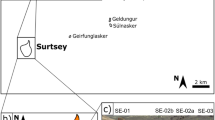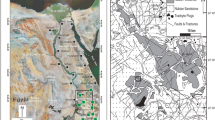Abstract
Microorganisms that inhabit sub-seafloor lavas are capable of etching volcanic glass and creating micron-sized tunnels and pits. Mineralization of these bioalteration traces ensures that these textures survive deformation and transformation of the host glass to metamorphic minerals. The fossil record of such bioalteration textures extends far beyond volcanic glass from in-situ oceanic crust to include meta-volcanic glass from ophiolites and Precambrian greenstone belts. Investigation of petrographic thin section reported here from ∼2.52 Ga tholeiitic pillow lavas from the Wutai Group of N. China found filamentous micro-textures. Laser Raman spectroscopy confirmed that these textures are mineralized by titanite. Moreover, the Wutai micro-textures are comparable in size, morphology and distribution to bioalteration textures from Archean greenschist facies pillow lavas. In-situ U-Pb dating of the titanite by laser ablation multi-collector inductively coupled plasma mass spectrometry (LA-MC-ICP-MS) gives an age of 1.81 ± 0.12 Ga (2σ, n=22, 206Pb/238U weighted average). This provides a minimum age for the mineralization of these candidate bioalteration textures and corresponds to a regional metamorphic event. This also represents a minimum age estimate for the timing of bioalteration and is compatible with the existence of a Late Archean-Proterozoic sub-seafloor biosphere.
Similar content being viewed by others
References
Furnes H, Banerjee N R, Muehlenbachs K, et al. Early life recorded in Archean pillow lavas. Science, 2004, 304: 578–581
Furnes H, McLoughlin N, Muehlenbachs K, et al. Oceanic pillow lavas and hyaloclastites as habitats for microbial life through time — a review. In: Dilek Y, Furnes H, Muehlenbachs K, eds. Links Between Geological Processes, Microbial Activities and Evolution of Life. Heidelberg: Springer Verlag, 2007. 1–68
Banerjee N R, Simonetti A, Furnes H, et al. Direct dating of Archean microbial ichnofossils. Geology, 2007, 35: 487–490
Furnes H, Staudigel H, Thorseth I H, et al. Bioalteration of basaltic glass in the oceanic crust. Geochem Geophys Geosyst, 2001, 2, doi: 10.1029/2000GC000150
Fisk M R, Giovannoni S J, Thorseth I H. The extent of microbial life in the volcanic crust of the ocean basins. Science, 1998, 281: 978–979
McLoughlin N, Furnes H, Banerjee N R, et al. Ichnotaxonomy of Microbial Trace Fossils in Volcanic Glass. J Geol Soc London, 2009, 166: 159–170
Staudigel H, Furnes H, McLoughlin N, et al. 3.5 Billion years of glass bioalteration: Volcanic rocks as a basis for microbial life? Earth-Sci Rev, 2008, 89: 156–176
Ross K A, Fisher R V. Biogenic grooving on glass shards. Geology, 1986, 14: 571–573
Santelli C M, Orcutt B N, Banning E, et al. Abundance and Diversity of microbial Life in ocean crust. Nature, 2008, 453: 653–657
Mason O U, Stingl U, Wilhelm L J, et al. The phylogeny of endolithic microbes associated with marine basalts. Environ Microbiol, 2007, 9: 2539–2550
Giovannoni S J, Fisk M R, Mullins T D, et al. Genetic evidence for endolithic microbial life colonizing basalic glass/seawater interfaces. In: Alt J, Kinoshita H, Stokking L B, et al. eds. Proceedings of the Ocean Drilling Program, Scientific Results, Ocean Drill. Program, College Station, Texas, 1996, 148: 207–214
Torsvik T, Furnes H, Muehlenbachs K, et al. Evidence for microbial activity at the glass-alteration interface in oceanic basalts. Earth Planet Sci Lett, 1998, 162: 165–176
Bach W, Edwards K J. Iron and sulphide oxidation within the basaltic ocean crust: Implications for chemolithoautotrophic microbial biomass production. Geochim Cosmochim Acta, 2003, 67: 3871–3887
Thorseth I H, Torsvik T, Furnes H, et al. Microbes play an important role in the alteration of oceanic crust. Chem Geol, 1995, 126: 137–146
Staudigel H, Yayanos A, Chastain R, et al. Biologically mediated dissolution of volcanic glass in seawater. Earth Planet Sci Lett, 1998, 164: 233–244
Walton A W. Microtubules in basalt glass from Hawaii Scientific Drilling Project #2 phase 1 core and Hilina slope, Hawaii: evidence of the occurrence and behaviour of endolithic microorganisms. Geobiology, 2008, 6: 351–364
Furnes H, Muehlenbachs K. Bioalteration recorded in ophiolitic pillow lavas. In: Dilek Y, Robinson P T, eds. Ophiolites in Earth’s History. Geol Soc Spec Publ Lond, 2003, 218: 415–426
Furnes H, Muehlenbachs K, Torsvik T, et al. Microbial fractionation of carbon isotopes in altered basaltic glass from the Atlantic Ocean, Lau Basin and Costa Rica Rift. Chem Geol, 2001, 173: 313–330
Thorseth I H, Furnes H, Heldal M. The importance of microbiological activity in the alteration of natural basaltic glass. Geochim Cosmochim Acta 1992, 56: 845–850
Thorseth I H, Torsvik T, Torsvik V, et al. Keldysh-98 Scientific party. Diversity of life in ocean floor basalts. Earth Planet Sci Lett, 2001, 194: 31–37
Thorseth I H, Pedersen R B, Christie D M. Microbial alteration of 0–30-Ma seafloor and sub-seafloor basaltic glasses from the Australian Antarctic Discordance. Earth Planet Sci Lett, 2003, 215: 237–247
Staudigel H, Furnes H, Kelley K, et al. The oceanic crust as a bioreactor. AGU Monograph, 2004, 144: 325–341
Fisk M, Staudigel H, Smith D C, et al. Evidence of microbial activity in the oldest ocean crust. Eos Trans Am Geophys Union, 1994, 80(Suppl): 84–85
Furnes H, Banerjee N R, Staudigel H, et al. Bioalteration textures in recent to mesoarchean pillow lavas: A petrographic signature of subsurface life in oceanic igneous rocks. Precambrian Res, 2007, 158: 156–176
Banerjee N R, Furnes H, Muehlenbachs K, et al. Preservation of microbial biosignatures in 3.5 Ga pillow lavas from the Barberton Greenstone Belt, South Africa. Earth Planet Sci Lett, 2006, 241: 707–722
Staudigel H, Furnes H, Banerjee N R, et al. Microbes and Volcanos: A tale from the oceans, ophiolites and greenstone belts. GSA Today 2006, 16, doi: 10.1130/GSAT01610A.1
Fliegel D, Simonetti, A, McLoughlin N, et al. In situ dating of the oldest morphological traces of life on Earth. Trans Am Geophys Union, Fall Meet, 2008, (Suppl): 89
Furnes H, Banerjee N R, Muehlenbachs K, et al. Preservation of biosignatures in metaglassy volcanic rocks from the Jormua ophiolite complex, Finland. Precambrian Res, 2005, 136: 125–137
Schiffbauer J D, Yin L, Bodnar R J, et al. Ultrastructural and geochemical characterization of Archean-Paleoproterozoic Graphite Particles: Implications for Recognizing Traces of Life in Highly Metamorphosed Rocks. Astrobiology, 2007, 7: 684–704
Zhu S X, Chen H N. Characteristics of Palaeoproterozic stromatolites in China. Precambrian Res, 1992, 57: 135–163
Zhao G C. Paleoproterozoic assembly of the North China Craton. Geol Mag, 2001, 138: 87–91
Zhao G C, Sun M, Wilde S A, et al. Late Archean to Paleoproterozoic evolution of the North China Craton: key issues revisited. Precambrian Res, 2005, 136: 177–202
Zhao G C, Cawood P A, Wilde S A, et al. Metamorphism of basement rocks in the Central Zone of the North China Craton: implications for Paleoproterozoic tectonic evolution. Precambrian Res, 2000, 103: 55–88
Zhao G C, Wilde S A, Cawood P A, et al. Archean blocks and their boundaries in the North China Craton: lithological, geochemical, structural and P-T path constraints and tectonic evolution. Precambrian Res, 2001, 107: 45–73
Wilde S A, Zhao, G C, Sun M. Late Archaean to Early Palaeoproterozoic Magmatic Events in the North China Craton: the Prelude to Amalgamation. Gondwana Res, 2002, 5: 85–94
Kröner A, Wilde S A, Li J H, et al. Age and evolution of a Neoarchaean to early Palaeozoic upper to lower crustal section in the Wutaishan/Hengshan/Fuping terrain of northern China. J Asian Earth Sci, 2005, 24: 577–595
Kröner A, Wilde S A, O’Brien P J, et al. Field relationships, geochemistry, zircon ages and evolution of a Neoarchaean to Palaeoproterozoic lower crustal section in the Hengshan Terrain of Northern China. Acta Geol Sin, 2005, 79: 605–629
Kröner A, Wilde S A, Zhao G C, et al. Zircon geochronology of mafic dykes in the Hengshan Complex of northern China: evidence for late Palaeoproterozoic rifting and subsequent high-pressure event in the North China Craton. Precambrian Res, 2006, 146: 45–67
Wang Z H, Wilde S A, Wang K Y, et al. A MORB-arc basalt-adakite association in the 2.5 Ga Wutai greenstone belt: Neoarchaean magmatism and crustal growth in the North China Craton. Precambrian Res, 2004, 131: 323–343
Liu S W, Pan Y M, Xie Q L, et al. Geochemistry of the Palaeoproterozoic Nanying Granitoid Gneisses: constraints on the tectonic setting of the Central Zone, North China Craton. J Asian Earth Sci, 2005, 24: 643–658
Zhao G C, Cawood P A, Lu L Z. Petrology and P-T history of the Wutai amphibolites: implications for tectonic evolution of the Wutai Complex, China. Precambrian Res, 1999, 93: 181–199
Zhao G C, Wilde S A, Cawood P A, et al. Petrology and P-T path of the Fuping mafic granulites: Implications for tectonic evolution of the central zone of the North China craton. J Metamorph Geol, 2000, 18: 375–391
Zhao G C, Wilde S A, Cawood P A, et al. High-pressure granulites (retrograded eclogites) from the Hengshan Complex, North China Craton: petrology and tectonic implications. J Petrol, 2001, 42: 1141–1170
Wilde S A, Zhao G C. Archean to Paleoproterozoic evolution of the North China Craton. J Asian Earth Sci, 2005, 24: 519–522
Wilde S A, Cawood P A, Wang K Y, et al. Granitoid evolution in the Neoarchaean Wutai Complex, North China Craton. J Asian Earth Sci, 2005, 24: 520–520
Tian Y Q. Geology and Mineralization of the Wutai-Hengshan Greenstone Belt. Taiyuan: Shanxi Science and Technology Press, 1991. 244
Wilde S A, Cawood P A, Wang K Y, et al. Determining Precambrian crustal evolution in China: a case-study from Wutaishan, Shanxi Province, demonstrating the application of precise SHRIMP U-Pb geochronology. In: Malps J, Fletcher C J N, Ali J R, et al., eds. Aspects of the Tectonic Evolution of China. Geol Soc Spec Publ Lond, 2004, 226: 5–26
Simonetti A, Heaman L M, Chacko T, et al. In situ petrographic thin section U-Pb dating of zircon, monazite, and titanite using laser ablation-MC-ICP-MS: Inter J Mass Spectrometry, 2006, 253: 87–97
Ludwig K R. Isoplot/Ex, rev. 2.49: Berkeley geochronology center. Spec Pub 1A, 2001, 56
Scott C, Lyons T W, Bekker A, et al. Tracing the stepwise oxygenation of the Proterozoic ocean. Nature, 2008, 452: 456–459
Edwards K J, Bach W, McCollom T M. Geomicrobiology in oceanography: microbe-mineral interactions at and below subseafloor. Trends Microbiol, 2005, 13: 449–456
Hellevang H. On the forcing mechanism for the H2-driven deep biosphere. Inter J Astrobiol, 2008, 7: 157–167
Lui S W, Zhao G C, Wilde S A, et al. Th-U-Pb monzanite geochronology of the Luliang and Wutai Complexes: Constraints on the Tectonothermal evolution of the Trans-North China Orogen. Precambrian Res, 2006, 148: 205–224
Wang K Y, Wang Z, Yu L, et al. Evolution of Archaean greenstone belt in the Wutaishan region, North China: constraints from SHRIMP zircon U-Pb and other geochronological and isotope information. In: Cassidy K F, ed. Proceedings of the 4th International Archaean Symposium 2001. Ext Abstr, 104–105
Bai J, Wang R Z, Guo J J. The Major Geologic Events of Early Precambrian and their Dating in Wutaishan Region (in Chinese). Beijing: Geological Publishing House, 1992. 1–55
Izawa M R, Bridge N J, Banerjee N R, et al. Preservation of modern and ancient microbial ichnofossils in basaltic glass by titanite mineralization. Trans Am Geophys Unior, 2008, (Suppl): 89
Furnes H, Muehlenbachs K, Tumyr O, et al. Biogenic alteration of volcanic glass from the Troodos ophiolite, Cyprus. J Geol Soc Lond, 2001, 158: 75–4
Banerjee N R, Muehlenbachs K. Tuff Life: bioalteration in volcaniclastic rocks from the Ontong Java Plateau. Gechem Geophys Geosyst, 2003, 4, doi: 1029/2002GC000470
Author information
Authors and Affiliations
Corresponding author
Additional information
We thank L. Nasdala for assistance in obtaining the Raman spectroscopy data shown in Figure 5 and N. Banerjee for insightful discussions concerning microbial bioalteration. We also thank two anonymous reviewers for their constructive comments. This work was supported by a Norwegian Research Council Project, National Natural Science Foundation of China (Grant No. 40730315) and Hong Kong RGC GRF (Grant Nos. HKU7063/06P, 7066/07P and 7057/08P).
About this article
Cite this article
McLoughlin, N., Fliegel, D.J., Furnes, H. et al. Assessing the biogenicity and syngenicity of candidate bioalteration textures in pillow lavas of the ∼2.52 Ga Wutai greenstone terrane of China. Chin. Sci. Bull. 55, 188–199 (2010). https://doi.org/10.1007/s11434-009-0448-0
Received:
Accepted:
Published:
Issue Date:
DOI: https://doi.org/10.1007/s11434-009-0448-0




